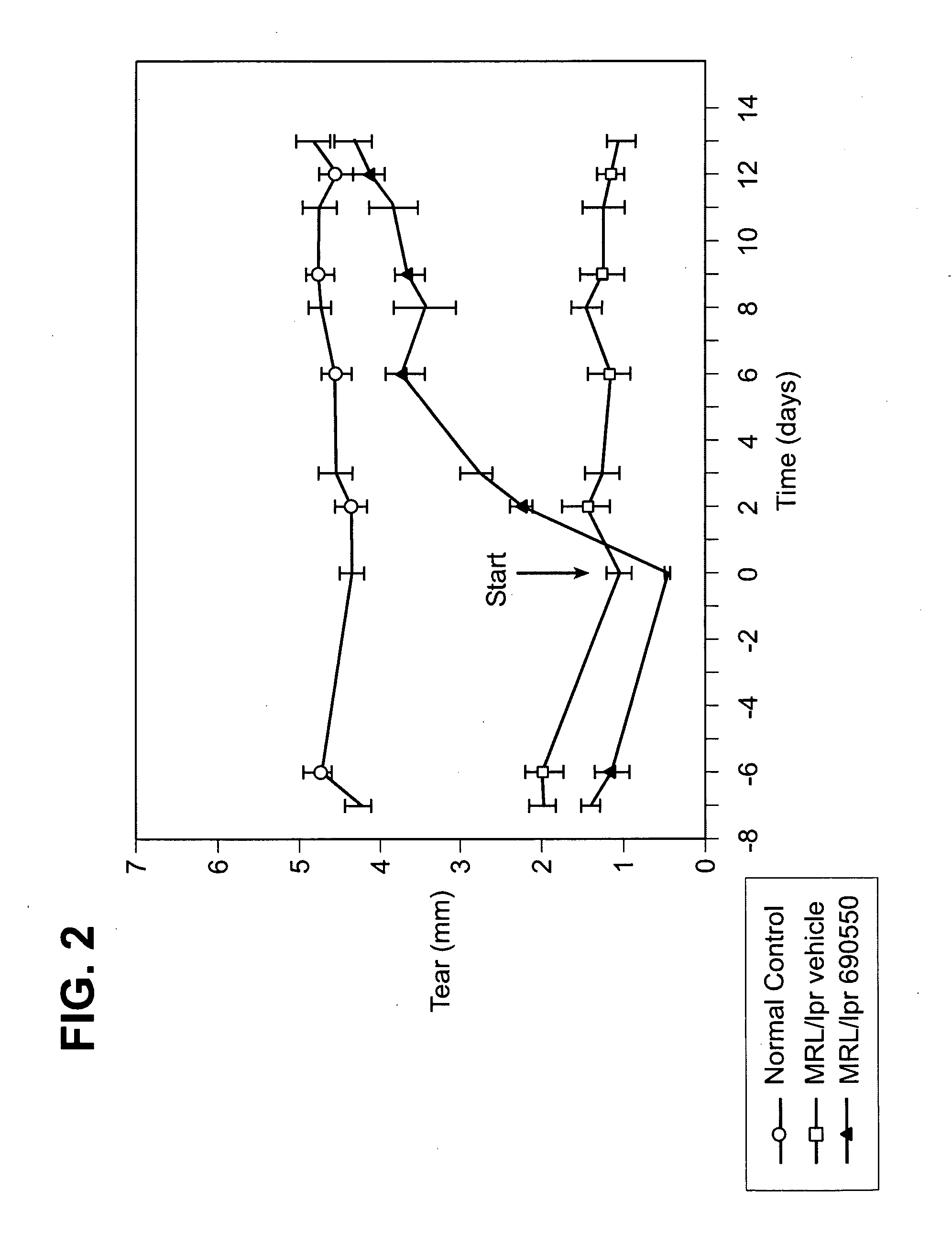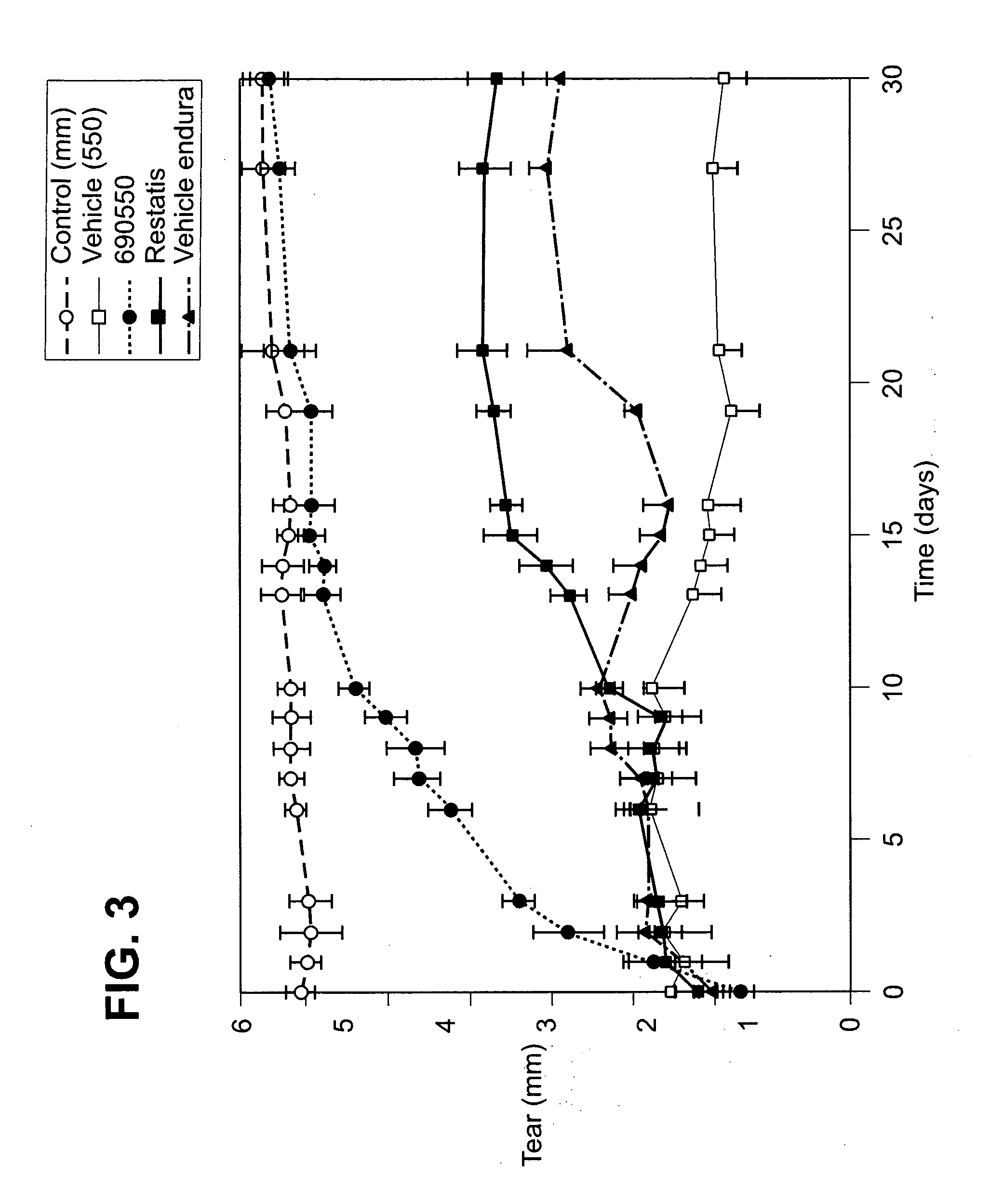Pharmaceutical compositions and methods of treating dry eye disorders
a technology of pharmaceutical compositions and compositions, applied in the direction of drug compositions, biocide, animal husbandry, etc., can solve the problems of increased patient pain, increased pain, and increased pain, so as to increase the production of tear film, increase the production volume, and increase the effect of tear production
- Summary
- Abstract
- Description
- Claims
- Application Information
AI Technical Summary
Benefits of technology
Problems solved by technology
Method used
Image
Examples
example 1
1-{4-Methyl-3-[methyl-(7H-pyrrolo[2,3-d]pyrimidin-4-yl)-amino]-piperidin-1-yl}-ethanone and 3-{(3R,4R)-4-Methyl-3-[methyl-(7H-pyrrolo[2,3-d]pyrimidin-4-yl)-amino]-piperidin-1-yl}-3-oxo-propionitrile
Method A: (1-Benzyl-4-methyl-piperidin-3-yl)-methyl-amine
[0094]To a stirred solution of 1-benzyl-4-methyl-piperidin-3-one (2.3 grams, 11.5 mmol), prepared by the methods of Iorio, M. A. and Damia, G., Tetrahedron, 26, 5519 (1970) and Grieco et al., Journal of the American Chemical Society, 107, 1768 (1985), (modified using 5% methanol as a co-solvent), both references are incorporated by reference in their entirety, dissolved in 23 mL of 2 M methylamine in tetrahydrofuran was added 1.4 mL (23 mmol) of acetic acid and the resulting mixture stirred in a sealed tube for 16 hours at room temperature. Triacetoxy sodium borohydride (4.9 grams, 23 mmol) was added and the new mixture stirred at room temperature in a sealed tube for 24 h, at which time, the reaction was quenched upon addition of 1...
example 2
Pharmaceutical Formulations
Example 2a
Formulations
[0102]Table 2 below illustrates various pharmaceutical formulations comprising the inhibitor CP0690550.
TABLE 2Formulation codeFormulation DescriptionFormulation 150 mM pH 7.4 phosphate buffer, 0.05% Tween80, 0.5% NaClFormulation 250 mM pH 7.4 Phosphate buffer, 0.36% HPMC,0.2% Glycerin, 1% PEG400, 0.35% NaClFormulation 35 mM pH 7.4 phosphate buffer, 0.36% HPMC,0.2% Glyerin, 1% PEG400, 5% CremophorELP, 4.3% MannitolFormulation 410 mM pH 5.8 citrate buffer, 4.5% MannitolFormulation 510 mM pH 5.8 citrate buffer, 4.2% Mannitol,0.36% HPMC, 0.2% GlycerinFormulation 60.3% tyloxapol (surfactant, nonionic), 0.5%Carbopol974P (polymeric stabilizer, anionic),2.25% D-mannitol, pH6.5 phosphate buffer at50 mM concentration, 230 mOsm / kgFormulation 70.3% tyloxapol (surfactant, nonionic), 0.1%Carbopol974P (polymeric stabilizer, anionic),2.25% D-mannitol, pH6.5 phosphate buffer at50 mM concentration, 230 mOsm / kg
example 2b
Preparation
[0103]Each of the above formulations 1 through 5 were prepared comprising the Jak3 inhibitor CP0690550 in three dosage amounts: 0.001%, 0.003% and 0.01% w / w. Formulation 5 was also prepared with the Jak3 inhibitor CP9690550 in the amount of 0.005% w / w (see FIG. 8). Formulations 6 and 7 were prepared comprising Jak3 inhibitor in the amount of 0.03% w / w.
[0104]The above formulations were prepared by adding the required amount of the tonicity agent (hypromellose, or mannitol where present) to a flask, heating to about to about 50° C. in half the final volume of buffer (phosphate or citrate buffer as indicated). After heating the batch quantities of inhibitor CP690550, the additional excipients (glycerin, polyethylene glycol 400, where indicated) were weighed and dissolved. The batch quantity of the Jak3 inhibitor free base as a stock solution was measured and added. Purified water was added to q.s. to 100%. The mixture was stirred for five minutes to homogenize and then filte...
PUM
| Property | Measurement | Unit |
|---|---|---|
| w/w | aaaaa | aaaaa |
| w/w | aaaaa | aaaaa |
| w/w | aaaaa | aaaaa |
Abstract
Description
Claims
Application Information
 Login to View More
Login to View More - R&D
- Intellectual Property
- Life Sciences
- Materials
- Tech Scout
- Unparalleled Data Quality
- Higher Quality Content
- 60% Fewer Hallucinations
Browse by: Latest US Patents, China's latest patents, Technical Efficacy Thesaurus, Application Domain, Technology Topic, Popular Technical Reports.
© 2025 PatSnap. All rights reserved.Legal|Privacy policy|Modern Slavery Act Transparency Statement|Sitemap|About US| Contact US: help@patsnap.com



